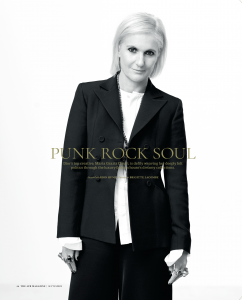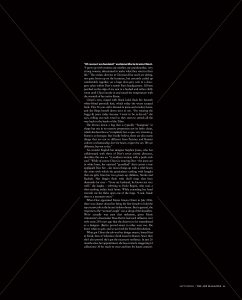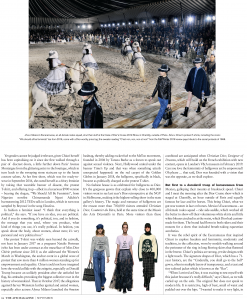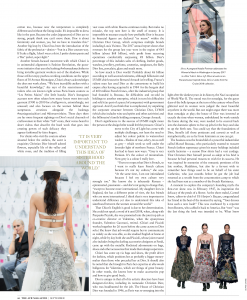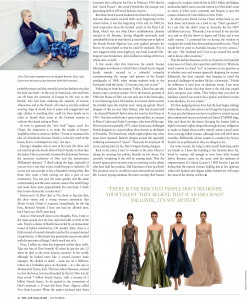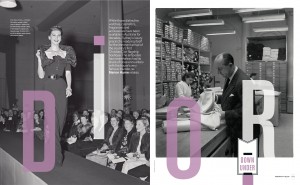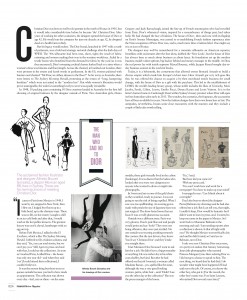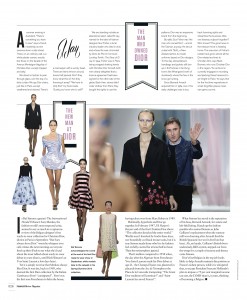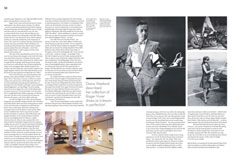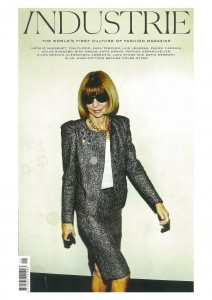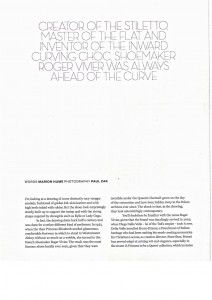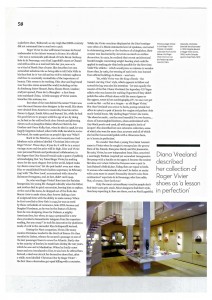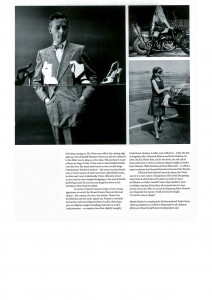Tag Archives: Christian Dior
Dior Down Under – Australian Financial Review
Dior Down Under
While those distinctive watches, cosmetics, fragrances and accessories have been available in Australia for decades, Sydney’s luxury precinct is readying itself for the imminent arrival of the country’s first Christian Dior flagship boutique. The antipodes has nevertheless had its share of close encounters with the house’s very famous founder, as Marion Hume relates.
The Australian Financial Review | December 2012
by Marion Hume
Roger Vivier, Ahead of the Curve
ROGER VIVIER AHEAD OF THE CURVE
ST MAGAZINE | September 2010
by Marion Hume
I’m looking at a design drawing of some distinctly racy strappy sandals, fashioned of arabesques of golden kidskin leather and with high heels inlaid with rubies. But the shoes look surprisingly sturdy, built up to support the instep and with the strong straps required by showgirls like Kylie or Lady Gaga.
In fact, the drawing dates back half a century and was done for a rather different kind of performer. In 1953, when the-then Princess Elizabeth needed glamourous, comfortable footwear in which to stand in Westminster Abbey without so much as a wobble, she turned to the French shoemaker, Roger Vivier. The result was the most famous shoes hardly ever seen, given they were invisible under the Queen’s Hartnell gown on the day of the coronation and have been hidden away in some palace archive ever since. The shock is, in the drawing, they look astonishingly contemporary.
You’ll doubtless be familiar with the name Roger Vivier, given the brand has been dazzlingly revived since 2003 when Diego Della Valle – he of the Tod’s empire – took it over. Della Valle installed Bruno Frisoni, a Frenchman of Italian heritage who had been making his mark creating accessories for Christian Lacroix, as artistic director. Since then, Frisoni has proved adept at mixing wit and elegance, especially in the recent, “A princess to be a queen” collection, including a platform “Balmoral” so sky-high HRH certainly did not command him to send a pair over.
Roger Vivier is also well known because its brand ambassador is the chicest woman in France. (Official; she won a nationwide poll ahead of Carla Bruni Sarkozy). Ines de la Fressange, once Karl Lagerfeld’s muse at Chanel and still as slim as a reed well into her 50s, now acts as a kind of North Star of taste. She describes her own somewhat nebulous role as being able to tell Della Valle to his face that he is “too old and too rich” to tolerate ugliness and thus to constantly remind him of the importance of beauty. This seems to be working. This shoe and bag brand now has nine stores around the world, including rue du Faubourg Saint-Honoré, Paris; Sloane Street, London and just opened, Plaza 66 in Shanghai, a first foray into mainland China. A little nosegay of Vivier scents launches this autumn too.
But what of the man behind the name? Roger Vivier was the most famous shoe designer in the world – really; his shoes were desired from America to Australia, from his native France to Egypt, South Africa and beyond. Yet while he had the good fortune to live until the age of 90, by doing so, he had so far outlived both close friends and glittering clients such as Josephine Baker, Marlene Dietrich, Ava Gardner and Grace Kelly, that when he died in 1998, he was largely forgotten. Indeed, when Diego Della Valle decided to revive the brand, the main question of people’s lips was “Who?”
Back in the 90s, you could sometimes find fabulous satin stilettos labelled “Christian Dior cree par Roger Vivier”. (These days, if you do, it will be in a posh vintage store and the price will be high). Dior and Vivier were personal friends and professional collaborators, to the point that Dior would make a point of publicly acknowledging that, “my friend Roger Vivier, (by) making shoes for the most elegant feet in the world, helped make my dream come true.” Yet the pair hadn’t even met when Dior re-established French fashion supremacy in February 1947 with “The New Look” (accessorised with shoes by Ferragamo). They didn’t meet until 1949.
So who was Roger Vivier? Born into the Parisian bourgeoisie, his young life changed radically when his father and mother died in quick succession leaving him an orphan. At the end of his teens, he dropped out of the Ecole des Beaux-Art to make shoes, thus forever linking a love of sculptural form with the ability to make money. When he first travelled to New York in 1935, he was as awed by those cathedrals of commerce, Saks 5th Avenue and Bergdorf Goodman as he was by the Statue of Liberty. Soon he was designing shoes for Delman, a mighty American firm but when, in 1937, a proposal for a new shoe provoked a transatlantic telegram reading “Are You Crazy?” he took his innovation for platforms made of cork to the surrealist, Elsa Schiaparelli instead.
During the Nazi Occupation, Vivier, like many creative Parisians, headed to the South of France. He then travelled to Lisbon from whence he secured a passage on one of the last passenger liners to cross the Atlantic. Partly due to the scarcity of leather, he made hats during the war years which he saw out in Manhattan. When he finally came home and was introduced to Dior, it was hats that he offered him. Instead, a deal was struck for decorative, jewel-encrusted shoes that, after a while, were labelled “Christian Dior by Roger Vivier”, the first time a shoe maker got equal billing with a couturier.
While the Vivier creations displayed at the Dior boutique were often of a Marie-Antoinette level of opulence, encrusted in shimmering jewels or the feathers of a kingfisher, the creator of them was fascinated by structure as much as surface decoration. In 1954, he realised that architectural breakthroughs concerning weight-bearing steel could be applied to making pin-thin heels possible for the first time. Voila! The stiletto, which would prove so ruinous to wooden floors that by 1965, the wearing of stiletto heels was banned from official buildings in France.
Yet while Vivier was the king of heels – the inward curving Choc heel which appears to follow and extend the leg was also his invention – he was equally the master of the flat. Diana Vreeland, the legendary US Vogue editrix who was known for sacking Voguettes if they didn’t polish the soles of their shoes with the same rigour as the uppers, wrote in her autobiography, DV, “no one ever got a sole as flat – as flat as tongues – as old Roger Vivier.” Not that Vreeland was averse to heels, posing outside her Vogue office in 1964 in a pair of jaunty fire-engine red python stack heeled boots. “My darling Roger Vivier,” she wrote, “the shoes he made… are the most beautiful shoes I’ve ever known…. shoes of hummingbird feathers, shoes embroidered with tiny black pearls and coral, all with exquisite heels of lacquer.” She described her own extensive collection, some of which she wore for over 20 years and all of which she had her housemaid polish with a rhinoceros horn as, “a lesson in perfection”.
No wonder then that a young Yves Saint Laurent came to Vivier when he sought to encapsulate the groovy Paris of his friends, Françoise Hardy and Zizi Jeanmaire. By 1965, Vivier, by now independent from Dior, conceived a seemingly-puritan yet somewhat transgressive flat pump with a buckle on its upper. It became the sexiest flat shoe ever when Catherine Deneuve wore a pair in Luis Bunuel’s “Belle de Jour”. Today, flats are equal to heels. “A woman who understands she won’t be better or sexier with 12-centimetres more is smart! Sensuality doesn’t come from centimetres!” says Ines de la Fressange, who then adds, “but of course I love heels too.”
Only the most extraordinary creative people don’t find their taste gets stuck. (Most designers find their style, then keep repeating it. Rare are those , such as Karl Lagerfeld, who keep moving on). Yet Vivier was still at the cutting edge aged 54. One of Rudolf Nureyev’s first acts after he defected to the West was to shop as a free man. His purchase, a pair of boots by Roger Vivier. Vivier was 61 when Brigitte Bardot wore his over-the-knee black boots as she crooned Serge Gainsbourg’s “Harley Davison”, the same year Jane Fonda wore a Vivier version of what were then called kinky boots, in silver and vinyl,in “Barbarella.” Officially Vivier retired in 1971, but he never stopped designing, to the end of his life preferring to talk of his “stamina” rather than his talent.
To revive a historic brand, it helps to have strong signatures to revisit. For Bruno Frisoni, there’s the heel shapes; the comma, the choc, the stiletto; there’s the jewelled flat, the snub square toe that was another Vivier creation. Frisoni is certainly having fun with that pilgrim buckle, these days seen on slightly naughty handbags that hint at a First Lady primness (no surprise then that slightly naughty Carla Bruni Sarkozy is often seen with hers) while the toes of Angelina Jolie, Gwyneth Paltrow and Katie Holmes are often covered in Vivier flats. As for the heels, the role call of those attracted to witty yet always elegant heights includes Kate Winslet and Tilda Swinton as well as Hollywood swan, Cate Blanchett, so often a repeat customer that she and Frisoni have become firm friends.
If Frisoni finds himself stuck for ideas, the Vivier oeuvre is a vast source of inspiration. If he feels like getting away from it all, his favourite place on earth is Conca dei Marini, on Italy’s Amalfi Coast, where Jackie O used to holiday wearing Vivier flats. But sometimes, he says, he just sits in his office at 29 rue Faubourg Saint Honore and channels the master. “I talk to God,” he laughs. “Or in this case, to Roger”

